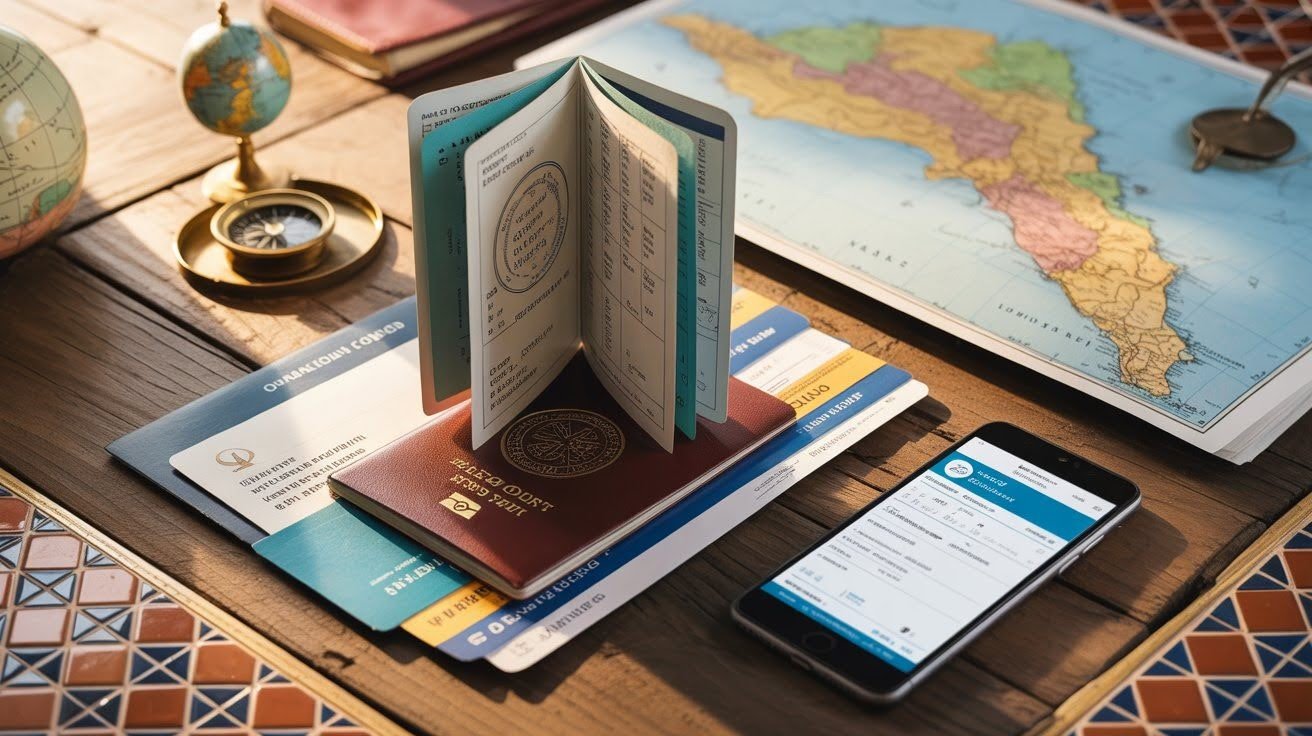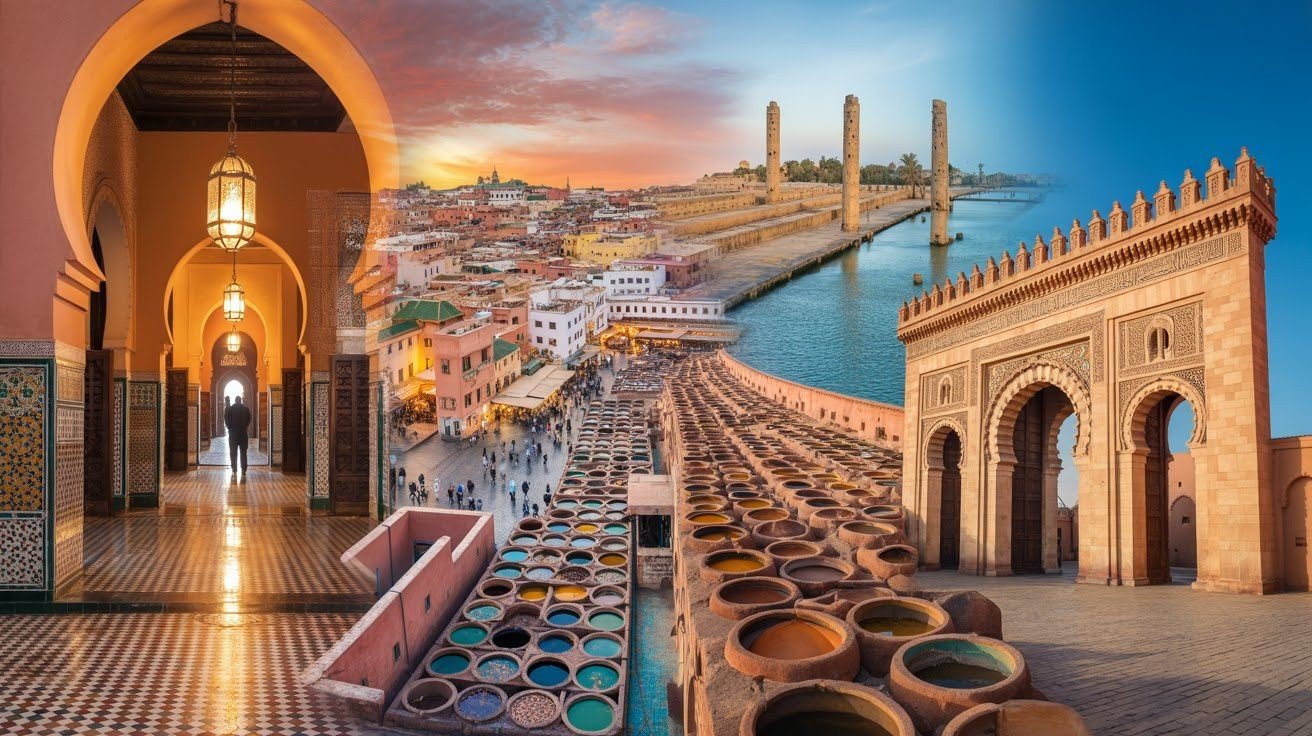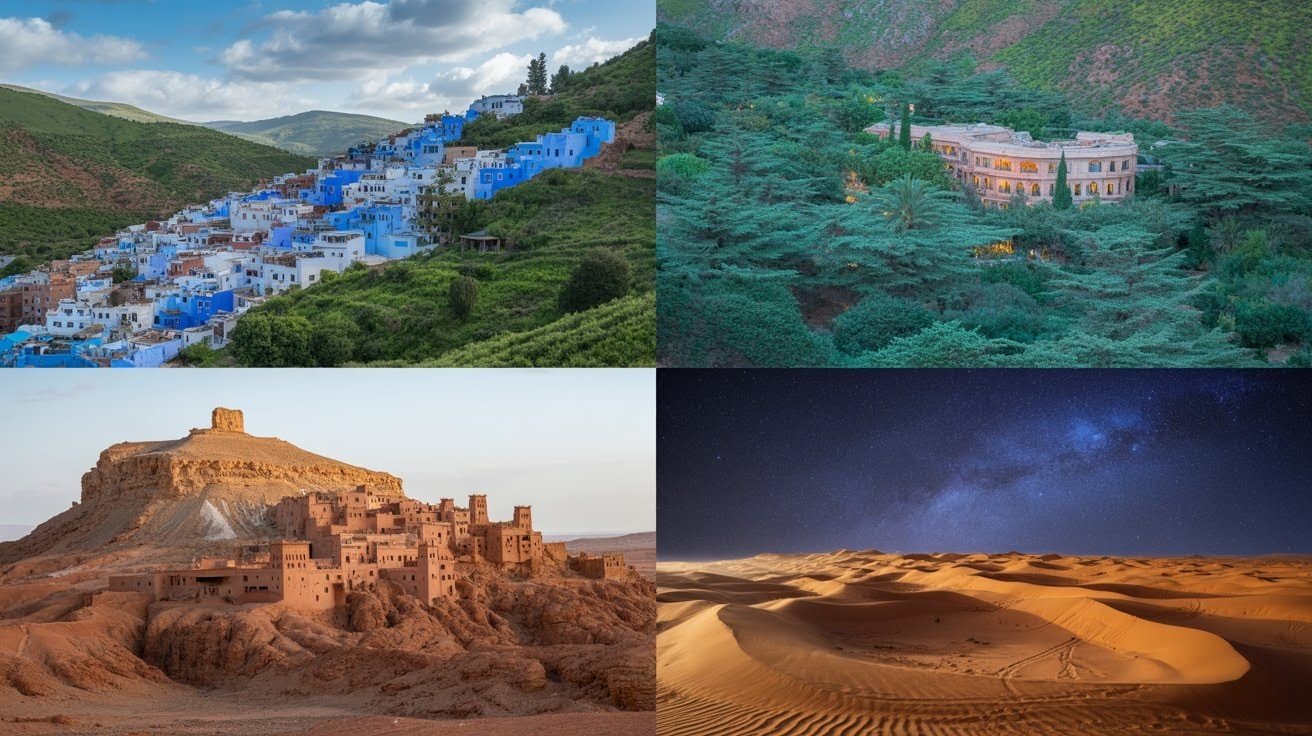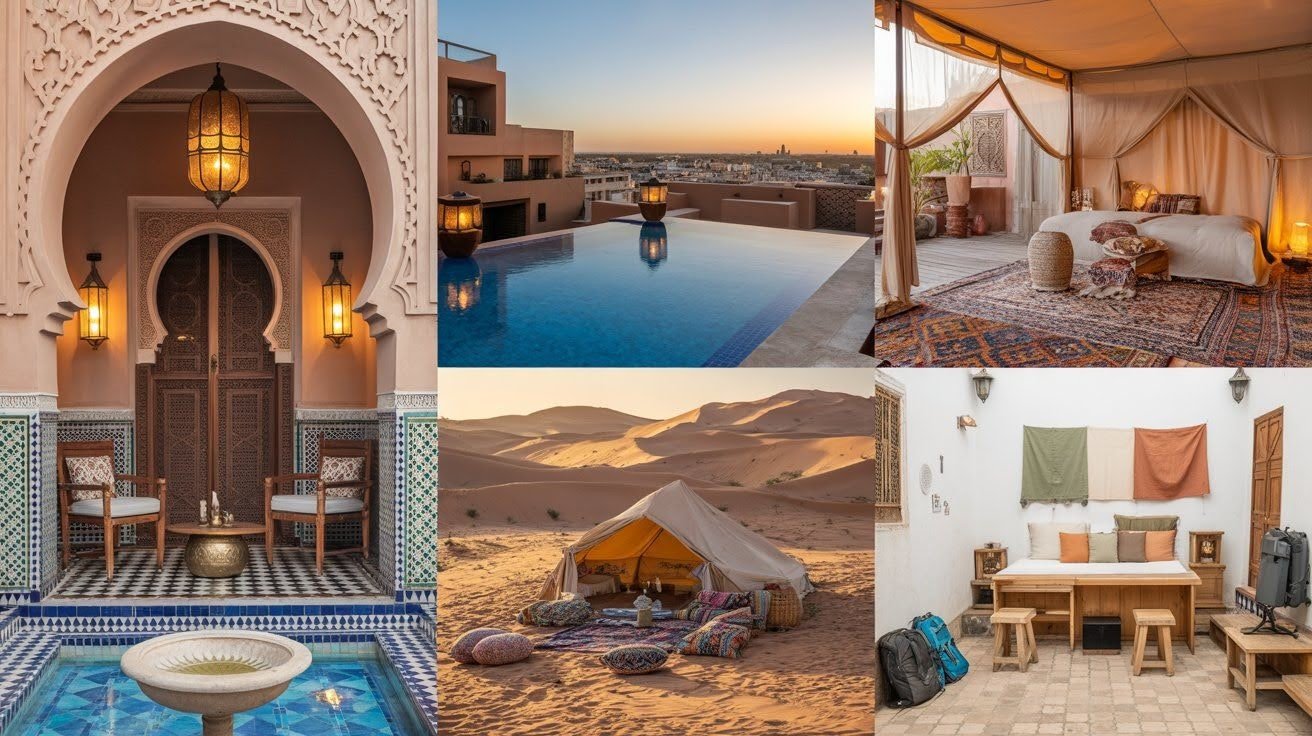Morocco sits at the crossroads of Africa and Europe, offering travelers a unique blend of cultures, landscapes, and experiences. This North African country combines ancient traditions with modern attractions in ways that surprise first-time visitors.
From the busy medinas of Marrakech to the quiet peaks of the Atlas Mountains, Morocco delivers variety at every turn. You can walk through historic imperial cities in the morning, ride camels across the Sahara dunes by afternoon, and relax on Atlantic beaches by evening.
This Morocco travel guide covers everything you need to plan your trip successfully. You’ll learn about visa requirements, the best times to visit, top destinations worth your time, and practical tips that make travel easier. We’ve included information from official tourism sources to help you prepare properly.
Planning Your Trip to Morocco
Good planning makes your Morocco trip smoother and more enjoyable. Understanding the basic requirements and logistics helps you avoid common problems and focus on having fun.
Visa Requirements and Entry Formalities

Most tourists can enter Morocco without a visa for stays of up to 90 days. Citizens from the United States, Canada, the United Kingdom, European Union countries, and Australia receive automatic entry stamps at airports and borders. Your passport must be valid for at least six months beyond your planned departure date from Morocco.
Keep your passport safe during your stay since you’ll need it for hotel check-ins and occasional police checkpoints. Make digital and physical copies of your passport’s main page before you leave home. If you plan to stay longer than 90 days, contact the Moroccan embassy in your country to learn about extension options.
Best Time to Visit

Morocco’s climate changes significantly between regions and seasons. Coastal areas stay mild year-round, while inland cities get very hot in summer and cold in winter. The Atlas Mountains receive snow from November through March, and the Sahara Desert reaches extreme temperatures during the summer months.
Spring (March to May) and fall (September to November) offer the most comfortable weather for most travelers. These seasons bring moderate temperatures, perfect for city tours and outdoor activities. Summer works well for beach destinations, but avoid inland areas during July and August when temperatures often exceed 100°F. Winter provides good value for budget travelers, though mountain areas may have limited access due to snow.
Getting to Morocco

Morocco’s main international airports serve as primary entry points for visitors. Mohammed V International Airport in Casablanca handles the most international flights, while Marrakech Menara Airport offers many direct connections from European cities. Rabat Sale Airport serves the capital, and Fes Saïss Airport provides another option for northern Morocco.
European travelers can reach Morocco in just a few hours, with direct flights from major cities like London, Paris, Madrid, and Frankfurt. North American visitors typically connect through European hubs, though some direct flights operate from New York and Montreal during peak seasons. Ferry services run regularly between Spain and Morocco, connecting Tarifa to Tangier in about 35 minutes and Algeciras to Tangier or Ceuta in roughly 90 minutes.
Top Destinations to Visit
Morocco packs remarkable diversity into its borders. Each region offers distinct experiences that appeal to different types of travelers.
Imperial Cities and Cultural Heritage

Marrakech stands as Morocco’s most famous city, where ancient and modern life mix in fascinating ways. The Djemaa El Fna square pulses with energy from sunrise to midnight, featuring storytellers, musicians, and food vendors. The Koutoubia Mosque towers over the medina with its 253-foot minaret, while the Bahia Palace showcases stunning Islamic architecture with intricate tilework and peaceful courtyards.
Fez contains the world’s oldest continuously operating university and a medina so complex that locals still get lost in its 9,000 narrow streets. Traditional craftsmen work in small workshops using methods passed down through generations, creating leather goods, ceramics, and metalwork. Rabat serves as Morocco’s political capital, offering royal palaces, museums, and a more relaxed atmosphere than other imperial cities. Meknes often gets overlooked, but it rewards visitors with impressive gates, fewer crowds, and proximity to the Roman ruins at Volubilis.
Coastal Towns and Beach Destinations

Essaouira Mogador combines a fortified medina with Atlantic Ocean breezes, creating a laid-back atmosphere popular with artists and surfers. The Portuguese-built harbor and ramparts create dramatic views, while the beach stretches for miles in both directions. Fresh seafood restaurants line the port, serving the day’s catch at reasonable prices.
Agadir and nearby Taghazout attract beach lovers and surfers with consistent waves and modern resort amenities. Tangier sits where the Mediterranean Sea meets the Atlantic Ocean, offering a gateway feel with ferries to Spain visible from the beach. El Jadida Mazagan preserves Portuguese colonial architecture within its old medina, including an underground cistern that creates an otherworldly atmosphere with its reflecting pools.
Nature and Mountain Escapes

Chefchaouen’s blue-washed buildings create one of Morocco’s most photographed settings. This small mountain town offers cool temperatures, friendly locals, and easy hiking in the nearby Rif Mountains. The relaxed pace makes it perfect for travelers seeking a break from bigger cities.
Ifrane sits high in the Atlas Mountains, resembling a European alpine town with its red-roofed houses and clean streets. Moroccan families vacation here during the hot summer months, enjoying cooler weather and nearby cedar forests. The Ouarzazate, Zagora, and Tinghir region serves as the gateway to desert experiences, with dramatic kasbahs and palm-filled valleys. Further east, Errachidia, Midelt, and Merzouga provide access to the true Sahara, where towering dunes and star-filled skies create unforgettable memories.
Getting Around Morocco

Morocco offers several transportation options that connect major cities and tourist destinations. The national rail system (ONCF) runs modern trains between Casablanca, Rabat, Fez, Marrakech, and Tangier with comfortable seating and reasonable prices. First class tickets cost only slightly more than second class but offer more space and quieter cars.
Long-distance buses fill gaps where trains don’t reach, with CTM and Supratours operating the most reliable services. These buses connect smaller towns and tourist sites, running on fairly punctual schedules with air conditioning and assigned seating. Booking tickets a day or two ahead during busy seasons ensures you get seats on your preferred departure times.
Car rentals give you the flexibility to visit remote areas and travel at your own pace. Major international companies operate at airports and in large cities, though driving in Morocco requires patience with aggressive local drivers and unclear road signs. \
Accommodation Options

Morocco provides lodging options for every budget and travel style. Your choice of where to stay significantly affects your overall experience.
- Traditional Riads: Authentic stays within medina walls featuring interior courtyards, rooftop terraces, and detailed tilework. These converted homes typically include breakfast and provide personal service from owners who share local knowledge.
- Modern Hotels: Properties in newer city districts offer familiar amenities like pools, gyms, and easier parking for those who prefer contemporary comfort over traditional settings.
- Desert Camps: Near Merzouga, options range from basic Berber tents to luxury glamping setups with proper beds and private bathrooms under star-filled skies.
- Budget Range: Clean hostels and simple hotels start around $15 per night, perfect for backpackers and cost-conscious travelers.
- Mid Range Options: Quality riads and hotels cost $50 to $100, offering good service, comfort, and authentic Moroccan design elements.
- Luxury Properties: High-end accommodations charge $200 and up but deliver exceptional experiences with spas, fine dining, and impeccable attention to detail.
Book popular riads several months ahead for travel during spring and fall when demand peaks. Read recent reviews carefully since quality varies significantly even within the same price range.
Essential Travel Tips
Smart preparation helps you handle practical matters smoothly and avoid common mistakes. These tips come from experienced travelers and locals who know what works.
- Currency and Payments: The Moroccan Dirham (MAD) serves as the official currency, with exchange rates around 10 dirhams to one US dollar. ATMs exist in all cities, dispensing dirhams at fair rates. Credit cards work at hotels and larger restaurants, but carry cash for markets, small shops, and taxis.
- Language Basics: Arabic and Berber serve as Morocco’s official languages, while French functions as the business and tourism language. Learning basic Arabic or French phrases helps with interactions, though many people in tourist areas speak some English.
- Communication and Connectivity: Phone coverage reaches most populated areas, with local SIM cards available cheaply at phone shops and providing much better rates than international roaming. WiFi works well in most hotels and many cafes.
- Health and Safety: Tap water meets safety standards in cities, but tastes heavily chlorinated, so most visitors stick to bottled water. Morocco ranks as one of Africa’s safest countries for travelers, with low crime rates and helpful police presence in tourist areas.
- Local Customs and Etiquette: Women should dress modestly outside beach resorts, covering shoulders and knees to show respect and avoid unwanted attention. Remove shoes when entering homes and some restaurants. Use your right hand for eating and greeting.
- Food and Dining: Moroccan food combines Mediterranean, Arabic, and Berber influences into flavorful dishes like tagine, couscous, and pastilla. Street food is generally safe if you choose busy stalls with high turnover. Mint tea accompanies most meals as a sign of hospitality.
- Useful Travel Apps: Download maps for offline use, currency converters, and translation apps before arriving. The ONCF app helps book train tickets, while CTM’s website works for bus reservations.
Following these practical tips makes your Morocco experience smoother and more enjoyable. Stay flexible and open-minded, as things don’t always run on schedule but usually work out in interesting ways.
Conclusion
This Morocco travel guide covers the key information you need to plan a successful trip to this fascinating country. Morocco delivers an incredible variety, from ancient medinas and imperial palaces to mountain villages and desert dunes. Each region presents unique experiences that appeal to different interests and travel styles.
Plan your itinerary based on what excites you most, whether that’s cultural immersion, outdoor activities, or relaxation. The practical information we’ve shared helps you handle logistics confidently so you can focus on enjoying your experiences.
Check the official Moroccan National Tourist Office website for current information on entry requirements, safety updates, and special events. Your Morocco trip will create lasting memories if you prepare well and stay open to unexpected moments.
Frequently Asked Questions
Is Morocco Safe for Solo Travelers?
Morocco is generally safe for solo travelers, including women. Stay aware in crowded areas, dress modestly, and trust your instincts. Tourist police patrol the main attractions regularly.
What Should I Wear When Visiting Morocco?
Cover shoulders and knees in public areas out of respect for local customs. Loose, breathable fabrics work best in hot weather. Beach resorts allow more casual clothing.
Can I Drink Tap Water in Morocco?
Tap water is treated and safe, but heavily chlorinated. Most travelers prefer bottled water, which is inexpensive and widely available throughout the country.
How Much Money Do I Need per Day in Morocco?
Budget travelers manage on $30 to $50 daily, mid-range visitors spend $75 to $150, and luxury travelers typically budget $200 plus per day for comfort and quality.
Do I Need Travel Insurance for Morocco?
Travel insurance is highly recommended for medical emergencies, trip cancellations, and lost belongings. Verify your policy covers Morocco and includes adequate medical coverage limits.

